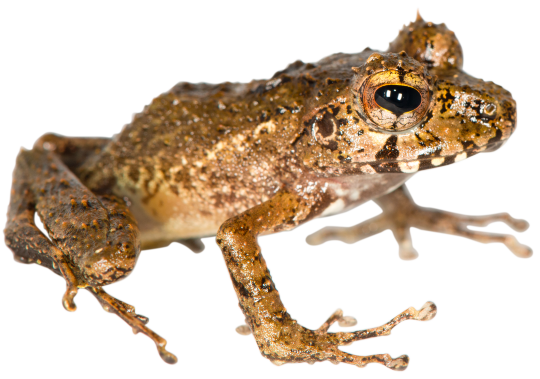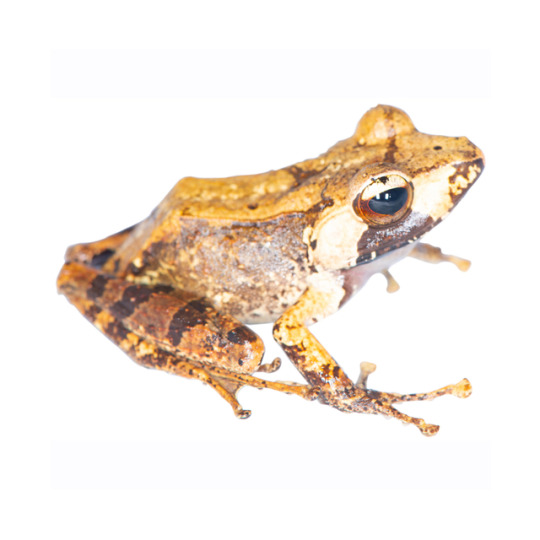#Duboimantis
Text

Meet Gephyromantis ampondo, one of four new species of frog that my colleagues and I described in a paper published this week in the journal Spixiana. We discovered this species in 2016 on a trip to the mountain of Marojejy in the northeast of Madagascar.
You can read the full paper here.
#frog#new species#biology#zoology#animals#taxonomy#Gephyromantis#Gephyromantis ampondo#Duboimantis#babe wake up four new frogs just dropped
616 notes
·
View notes
Photo

White Folohy Madagascar frog (Gephyromantis luteus)
Photo by Frank Vassen
#white folohy madagascar frog#gephyromantis luteus#duboimantis#gephyromantis genus#mantellinae#mantellidae#ranoidea#neobatrachia#anura#batrachia#amphibia#tetrapoda#vertebrata#chordata
246 notes
·
View notes
Photo

This is Gephyromantis (Duboimantis) sp. Ca17, an undescribed candidate species from Marojejy in northeastern Madagascar that is very similar to G. (D.) leucomaculatus. A large proportion of Madagascar’s frog diversity is unnamed. Part of the problem is species that are very difficult to distinguish from described species, or from which only very few voucher specimens are available in museum collections. The G. (D.) leucomaculatus species complex will await taxonomic resolution for some time, because we have several significant genetic lineages but most are represented by single specimens, are very similar morphologically, and are lacking call recordings that are often important to the taxonomy of these frogs. . . . . . . . #frog #madagascar #Gephyromantis #Duboimantis #Amphibian #beautiful #cute #animal #animals #frogs #unnamedspecies #amphibians #amphibiansofinstagram #frogsofinstagram #taxonomy #naturalworld #herpetology #herps #herping #diversity #wildlife #fieldwork #zoology #photography #photographer #photographersoninstagram #photographersofinstagram #rainforest #systematics #science https://www.instagram.com/p/B2Hke_Nh9ls/?igshid=v9qlh0w5w57p
#frog#madagascar#gephyromantis#duboimantis#amphibian#beautiful#cute#animal#animals#frogs#unnamedspecies#amphibians#amphibiansofinstagram#frogsofinstagram#taxonomy#naturalworld#herpetology#herps#herping#diversity#wildlife#fieldwork#zoology#photography#photographer#photographersoninstagram#photographersofinstagram#rainforest#systematics#science
16 notes
·
View notes
Photo

Gephyromantis cf. plicifer by brian.gratwicke on Flickr.
#frog#Madagascar#animals#amphibians#Anura#Gephyromantis#Gephyromantis (Duboimantis) plicifer#Duboimantis
181 notes
·
View notes
Text
Two years ago, I travelled with a team of international and Malagasy researchers to a remote forest in the north of Madagascar, on ‘Expedition Angano.’ The goal of the expedition was to study forest fragmentation and its impact on reptile and amphibian biodiversity and distribution, as well as to identify potentially new species. Among the team was a talented videographer, Duncan Parker, whose work has featured in such notorious BBC documentaries as Planet Earth 2 and Natural World. He worked tirelessly filming the expedition. Now, he and his team at Falcon Productions have put together a documentary, and it is being released for free viewing.
Antsolipa forest, where our research was conducted. Photo by Duncan Parker.
Calumma malthe, one of the most common reptiles in the forest. Photo by Duncan Parker.
Uroplatus sikorae, one of the more elusive species in the forest; we found only two specimens. Photo by Duncan Parker.
A view of my desk, preparing and cataloguing specimens. Photo by Duncan Parker.
The feature-length documentary, entitled ‘Madagascar – Life on the Edge,’ tells the story of our research on dwindling rainforest fragments in northern Madagascar in thrilling HD. It highlights the beauty of the forest, but also the stark contrast between it and the ever encroaching deforestation, and brings to the fore the Malagasy researchers that are so important for the future of Madagascar’s habitats, and their personal feelings for the conservation mission.
Madagascar bee eaters, a species that often frequents the zones near the edge of the forest. Photo by Duncan Parker.
The forest is home to a wealth of fungi. Duncan was quite taken by them. Photo by Duncan Parker
One of our guides in the savannah between forest fragments. Photo by Duncan Parker.
I could talk about the film at greater length, but I think it really speaks for itself, so without further ado, you can watch ‘Madagascar – Life on the Edge’ here!
To read more about Expedition Angano and its outcomes, you can see the following previous posts on this blog:
A small new chameleon from northern Madagascar
Expedition Angano
A year or so in review
And James Borrell’s blog:
The honey hunter and other incredible field assistants (includes a short film shot by Duncan Parker)
Launching Expedition Angano: conservation fieldwork in northern Madagascar
To read the expedition report to funders and stakeholders, click here.
The expedition was funded by the Zoological Society of London, Royal Geographical Society, Scientific Exploration Society, Cadogan Tate, Royal Meteorological Society, Queen Mary University of London and donations through Indiegogo.
Below you will find some of my photos of a few reptiles and amphibians encountered on this trip.
Gephyromantis (Duboimantis) sp. nov.
Calumma gehringi, a recently described species of which many specimens were collected on our expedition
Gephyromantis (Asperomantis) tahotra
Uroplatus sp.
Gephyromantis (Duboimantis) sp. nov.
Gephyromantis (Laurentomantis) horridus
Note: I am current in the field in Madagascar; this post has been released using a scheduler.
New Film: Madagascar - Life on the Edge! Click here to watch: Two years ago, I travelled with a team of international and Malagasy researchers to a remote forest in the north of Madagascar, on '
#amphibians#expedition#film#forest#frogs#gecko#herpetology#Life on the Edge#madagascar#reptiles#research#science#travel#wildlife
75 notes
·
View notes